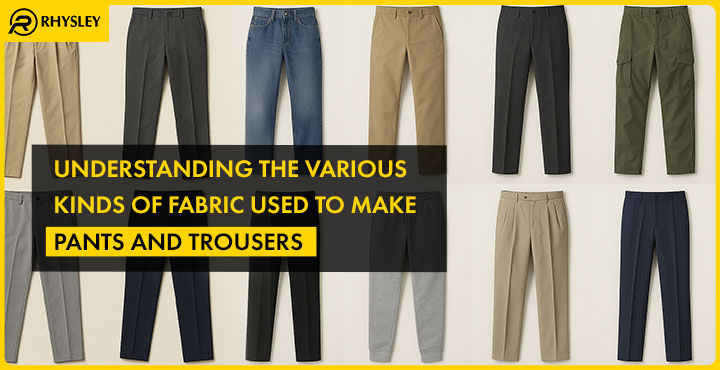
Understanding the Various Kinds of Fabric Used to Make Pants and Trousers
Modern garment manufacturing involves a complex blend of textile innovations, where choosing the right fabric for pants goes beyond just looks to encompass a broader approach to lifestyle design. Selecting the perfect material for trousers is a careful balance between technological progress, environmental factors, and personal comfort needs.
More and more, consumers are realizing that the fabric of their pants significantly impacts daily comfort, professional appearance, and overall satisfaction with the garment. This detailed overview aims to shed light on the wide variety of trouser fabrics available, helping readers make informed decisions and better understand the different properties of each material.
As part of the broader landscape of clothing manufacturing, understanding how pants fabrics are selected and produced is essential to making informed wardrobe choices that suit both function and fashion.
Why Fabric Choice Matters for Pants and Trousers
The pants fabric material you choose affects much more than appearance. It influences:
Comfort:
A comfortable fabric for pants ensures ease of movement and all-day wearability.
Durability:
Good fabric for pants resists wear and tear, especially for work or outdoor use.
Maintenance:
Some fabrics need dry cleaning, while others are machine washable.
Occasion Suitability:
Different types of pants fabric suit formal, casual, or active settings.
Natural Fabrics for Pants and Trousers
Cotton: A Classic and Comfortable Fabric for Pants
Cotton is among the most popular fabrics for pants. Known for its breathability and softness, it is a versatile choice for casual and semi-formal wear. Pure cotton or cotton blends make great pant fabric for daily use, offering comfort and ease of care.
Linen: The Lightweight Trouser Material Fabric for Warm Weather
Linen is a premium trouser material fabric ideal for hot climates. Its natural texture keeps you cool and stylish. However, linen tends to wrinkle easily, so it suits more relaxed, laid-back settings.
Wool: The Best Fabric for Trousers in Formal Wear
When it comes to dress pants, wool is often the best fabric for trousers. It drapes beautifully, provides warmth, and maintains a sharp, professional look. Wool blends offer added durability and wrinkle resistance.
Synthetic Fabrics for Pants
Polyester Fabric for Pants: Durable and Wrinkle-Resistant
Polyester fabric for pants is widely used thanks to its strength, affordability, and wrinkle resistance. It’s ideal for work trousers and uniforms. Often blended with natural fibers, polyester enhances durability and reduces shrinkage.
Nylon: A Common Cargo Pants Fabric
Nylon is lightweight, strong, and often used in cargo pants fabric. It’s great for outdoor activities, offering water resistance and quick-drying properties.
Rayon and Blends: Affordable and Soft Pants Fabric Material
Rayon mimics the feel of natural fabrics but comes at a lower cost. Blended with other fibers, it creates a pant fabric that’s soft, drapey, and versatile.
Read More : Type of pants are considered business casual
Specialty Fabrics and Blends
Denim: The Iconic Pants Fabric
No discussion on pants fabric material is complete without mentioning denim. This cotton twill fabric is durable, stylish, and perfect for casual wear.
Corduroy: A Warm Option for Men’s Trousers
Corduroy is a ribbed cotton fabric ideal for chilly seasons. It’s sturdy and adds texture to fabric for men’s trousers.
Spandex and Stretch Fabrics: For Flexible Comfort
Stretch fabrics that include spandex or elastane are often used in modern pant fabric blends. They provide flexibility, ideal for activewear or slim-fit styles.
Best Fabric for Pants Based on Purpose
Formal Trousers Material
For formal occasions, opt for wool, wool blends, or high-quality polyester fabric for pants. These fabrics offer structure and polish.
Casual Pants Fabric for Men
Cotton, denim, and corduroy make great casual pants fabric. They are comfortable and easy to maintain.
Sports and Cargo Pants Fabric
Look for nylon, spandex blends, or technical fabrics designed for movement and durability.
Frequently Asked Questions
What are the most common fabrics used in pants and trousers?
Cotton, polyester, wool, denim, linen, and blends of these are the most common fabrics used in pants and trousers.
Which fabric is best for summer trousers?
Linen and lightweight cotton are the best fabrics for summer trousers as they’re breathable and keep you cool.
What fabric is best for formal trousers?
Wool and wool-blend fabrics are ideal for formal trousers due to their elegant drape and polished look.
Is polyester a good fabric for pants?
Yes, polyester is durable, wrinkle-resistant, and easy to care for, making it a good fabric for everyday pants.